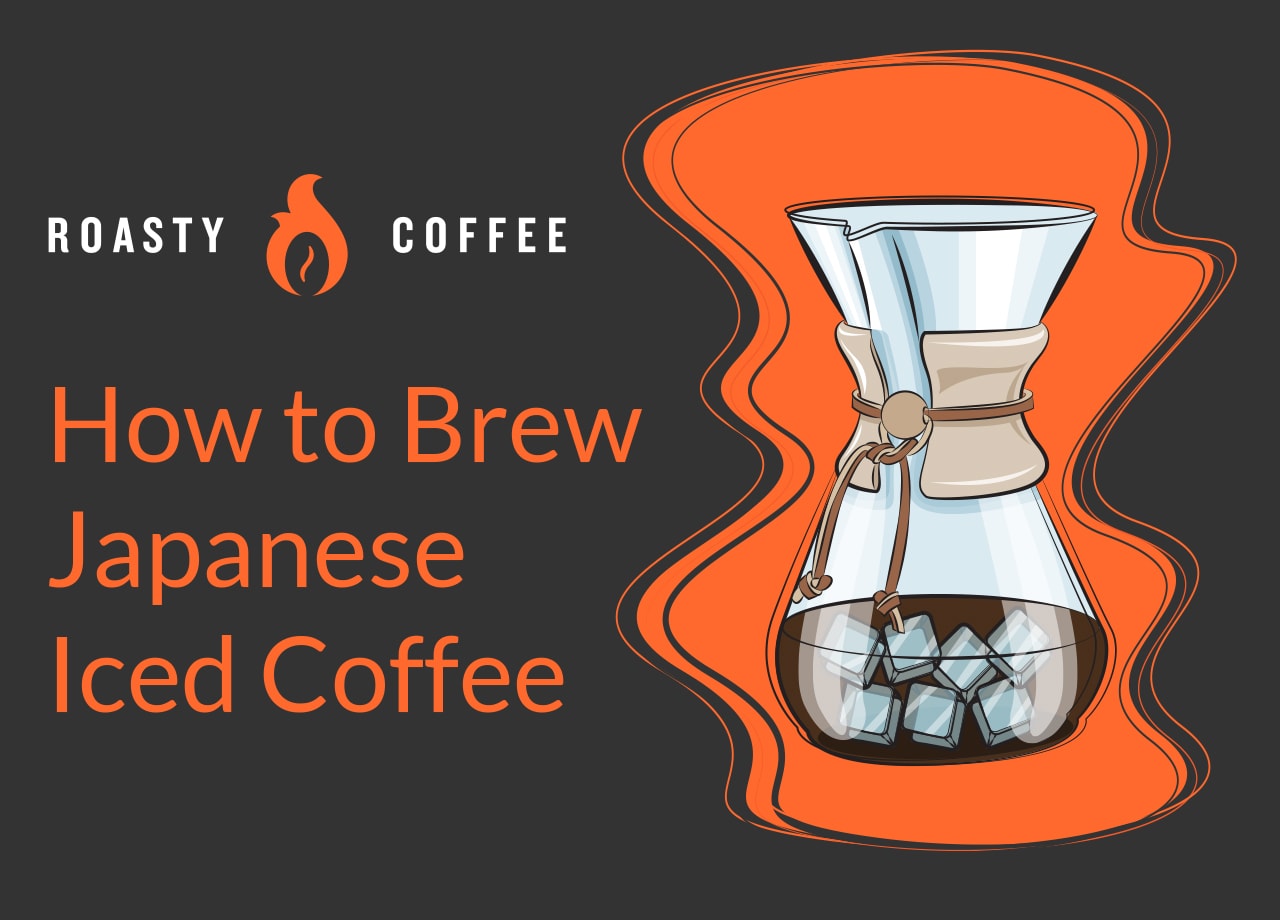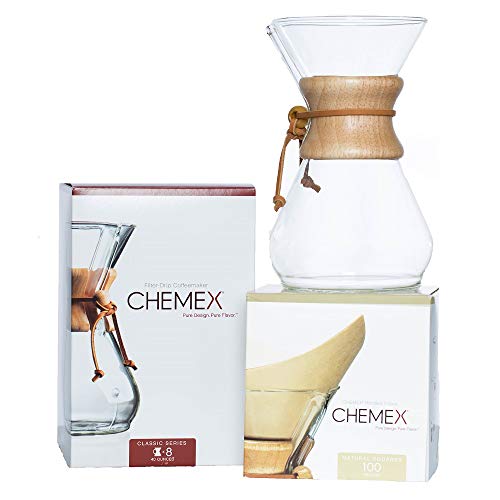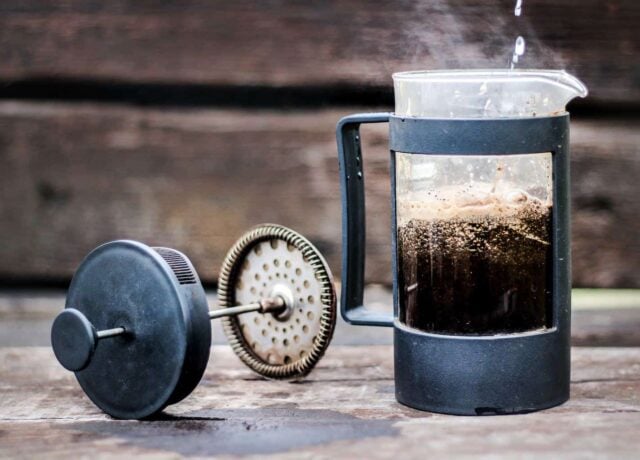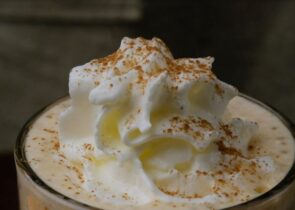
Iced coffee has become all the rage in recent years, and for good reason. It’s delicious! But I bet many of you have yet to try Japanese iced coffee.
The biggest problem with iced coffee is the brewing method. Cold brew methods take a long time and they simply can’t extract all the intricate flavors to be found and enjoyed in coffee beans. That is where Japanese iced coffee comes in. Using this method, you can enjoy iced coffee that is filled will flavor and is just a cut above all of the other cold brew methods out there.
What Is Japanese Iced Coffee?
Japanese iced coffee refers to a brew method that first rose to prominence in Japan. The final coffee you enjoy doesn’t actually have ice in it. Instead, half of the water you use during the brewing process is ice instead of hot water.
This method is prepared using a Chemex or other pour-over methods and typically is made with a double-strength batch of coffee. The result is a stronger cold coffee treat filled with flavor that is perfect for a hot summer afternoon treat.
What You Will Need
Before we begin, we need to make sure we have everything we need for this surprisingly simple and delicious brewing method. Below you will find the tools and ingredients you will need:
- Ice Cubes
- Chemex or Melitta Drip Cone
- Fresh Ground Coffee
- Hot Water
As you can see, you don’t really need a lot of equipment or ingredients to make this type of coffee, but we do recommend that you use a proper type of coffee maker for this job as it is the only way to truly replicate this style of iced coffee.
Brewing Japanese Iced Coffee
Are you ready to begin preparing your cup of Japanese iced coffee? I hope so. Let’s get started. For the purposes of this guide, we will be preparing a single 16-ounce cup of Japanese iced coffee.
Step 1: Measure Your Ice
To begin, add your ice to your Chemex. For the best results, be sure you use a kitchen scale. For a 16 oz. cup of Japanese iced coffee, add 8 ounces of ice to the Chemex to account for approximately half of your finished volume.
Step 2: Prepare Your Coffee
Grind your coffee of choice and measure out about 1.8 grams of coffee for every finished ounce of brewed coffee. For best results, try using a medium-coarse ground. So, for a 16 oz. beverage, you will use about 30 grams of coffee. If you don’t have a scale handy, each tablespoon is equal to about 5 grams of coffee.
Step 3: Boil Your Water
Boil your water on the stove or with your electric kettle until it reaches somewhere between 195°F and 205°F. Once it reaches this temperature, immediately remove it from the heat.
Step 4: Brew the Coffee
Pour the hot water over the grounds. Since we are making a 16 oz. cup and we already have 8 ounces of ice, add 8 ounces of hot water and allow it to brew. During this process, the hot coffee will pour over the ice, melting it while unlocking some of the rich and wonderful flavors in the coffee.
Step 5: Pour Into Glass and Serve
During the brewing process, much of the ice will melt. The goal is to have it all melt, but if there is some left don’t worry. You will still have an amazing cold up of Japanese iced coffee. Pour the coffee into a glass and enjoy your coffee. It really is the perfect pick me up for a hot summer afternoon.
Alternative Brewing Methods
We’ve already gone over how to use a Chemex to make Japanese iced coffee. But one of the best things about this brewing technique is that you can use pretty much any tool you have on hand.
Read on for a quick guide on how to use an Aeropress, Pour Over, and Auto Drip Brewer to make Japanese style iced coffee.
Aeropress
First up, we have one of our favorite brewing tools, the AeroPress. For this method, you have a lot of variability for the water to coffee ratio, but we recommend going stronger than you typically would to account for the ice. For those of you who prefer to use weight ratios rather than the AeroPress markings, you can go anywhere from 20:1 to 12:1.
You can use either the standard or inverted method. We prefer the latter, so that is what we’ll be covering here. For the most part, the process is identical. Put together the plunger and chamber with the open end facing up. Fill the chamber with grounds, bloom, then submerge. While they’re steeping, wet your filter and screw it on.
Here’s where you will mix things up. Instead of warming up your cup, you’re going to put ice in it. You are going to have to be extra careful when you flip the Aeropress because the mug won’t be on top to keep you from making a mess. So make sure to hold everything together and tilt the top to where it is over the mug before completely flipping it.
Plunge until you hear a hissing noise, then go ahead and clean off your Aeropress to allow time for the ice to melt a bit. Then enjoy!
Pour Over
Next up, we are going to cover how to use non-chemex pour over tools to make your Japanese iced coffee. You can use anything from a Hario V60 to a Kalita Wave, but most people recommend using a higher coffee to water ratio with the former (~1:18) than the latter (~1:20). But, as always, it is up to personal preference.
First, you are going to fill your carafe or mug with ice. Then you put the pour-over tool on top and proceed as usual. Again, you should increase the amount of coffee you would normally be using to account for the dilution that will occur as the ice melts.
Using a pour-over is great because it is a little slower than other brewing methods, so the ice melts as you are pouring in the hot water. That way, when you are done, it’s perfect for drinking.
Automatic Drip
Lastly, if you are looking to make a larger batch of Vietnamese iced coffee, you could always reach for your automatic drip brewer. The biggest thing to remember is that you cannot brew a full pot of coffee as it will overflow.
An easy way to measure things out is to fill the pot halfway with cold water, then add ice until you reach a full pot. Pour the water into the reservoir, keeping the ice in the pot. Alternatively, you can just eyeball it or actually weigh everything out.
Next, you need to brew a strong pot of coffee over the ice. It should melt as you brew, creating a nice, cold brew by the end of it. It’s especially effective if your automatic brewer has an iced coffee option.
Hot Tips for this Chilled Brew
Hitting the right balance of strength with the grounds, water, and ice involved in this brewing technique. But we do have some tips to help you nail it a little bit faster:
Go for a finer grind
Opting for a finer grind will give you a stronger brew. While you should still stay within the parameters of what is appropriate for your brewing tool, going a setting or two finer is a great way to get a stronger brew without having to fool too much with ratios.
Up the coffee to water ratio
If you don’t want to bother weighing and measuring all your ice and water to exactitude, you can simply brew your coffee a bit stronger than usual by upping the amount of grounds you are using for the amount of water. This will account for the dilution that occurs as the ice melts.
How Does Japanese Iced Coffee Compare?
Regular Iced Coffee
Japanese iced coffee and regular iced coffee are pretty similar. Japanese coffee involves brewing hot coffee directly over ice with the intention that it will at least partially melt. On the other hand, your run of the mill iced coffee is brewed first, allowed to cool a bit, and then poured over ice.
The difference comes out in the flavor. Japanese iced coffee tends to be stronger with more complex, noticeable flavor profiles. Iced coffee can be rather weak and is often accompanied by sugar and milk.
Cold Brew Coffee
There is a much bigger difference between cold brew and Vietnamese iced coffee than in the previous comparison. The separation here is in the brewing temperature.
Traditional cold brew coffee never introduces hot water into the mix. Instead, the brew is made by using room temperature or chilled water and steeping for 14 to 20 hours. Vietnamese ice coffee is chilled as it is brewed with hot water.
However, there is such thing as a shot bloomed cold brew which gives a profile that is a balance between the two types of brewing. Instead of making the entire brew hot or cold, the grounds are bloomed with hot water, then brewed in cold water.
The flavor profile of the latter brewing method is actually rather similar to Japanese iced coffee, though it is still less acidic.
Vietnamese Iced Coffee
Now, Japanese and Vietnamese coffee are probably the furthest away from each other. Vietnamese iced coffee is made by using a very specific brewing tool. It creates a very strong brew that is then mixed with condensed milk and poured over ice.
So the brews are really different in both taste and texture as well as brewing method. Still, both of them are definitely worth trying sometime.
The Last Drop
Japanese iced coffee is one of the easiest ice coffee brewing methods out there, and it creates a cold coffee that is truly unique in the process thanks to the unique brewing method. The end result is a delicious cup of iced coffee that has almost no ice in it, and the tastes and flavors it brings are truly something unique and special.
If you have been searching for a new way to enjoy your favorite coffee, we highly recommend this method. So give it a try and let us know what you think of the results. In the end, we believe you will be delighted and given how easy it is, we are betting that you will start enjoying this iced coffee all summer long.
Enjoy!










